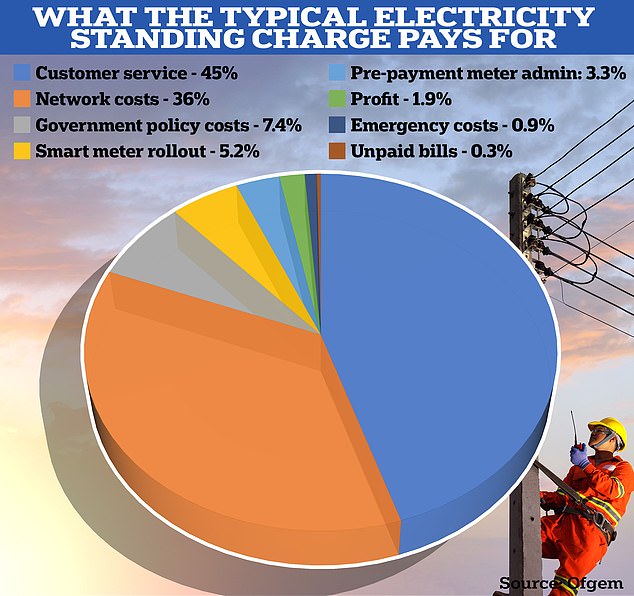Why are standing charges going up, when the energy price cap is falling?
How much we pay per unit of energy is falling, but daily fixed costs are rising – and will soon add more than £300 a year to the average bill for the first time.
Most households will see a welcome drop in energy prices, with the Ofgem limit falling from £2,074 to £1,923 per year for the average home from October 1.
The Ofgem price cap limits the amount you can be charged for the gas and electricity you use if you have a variable rate and pay by direct debit.
The drop on October 1 comes as unit rates – how much you can be charged for each unit of gas and electricity you use – become cheaper.
Don’t stand still: fixed costs have been rising steadily since 2021
But while the price we pay for the gas and electricity we use may be falling, the price we pay for daily standing charges is actually going up – and is expected to rise even further.
Currently the average electricity rate is 30.11 pence per kilowatt hour (kWh), which will fall by 9 percent to 27.35 pence per kWh on October 1.
For gas, the typical unit rate is currently 7.51 pence per kWh, which will fall by 8.2 percent to 6.89 pence per kWh from October.
Meanwhile, the typical standing charge for electricity is 53 cents per day and will not change on October 1. For gas, the typical standing charge will increase by 1 cent to 30 cents.
These may seem small increases, but fixed costs have more than doubled in two years and are expected to continue to rise.
From October 1, the average home will pay £193.45 in fixed charges for electricity per year and £109.50 for gas, bringing the total to more than £300 for the first time.
Just two years ago, in the summer of 2021, the typical standing charge for electricity was £91.25 and £98.55 for gas.
This rapid increase in fixed costs has attracted fierce criticism from consumer champions – not least because it cannot be avoided by simply reducing energy consumption, as is the case with unit rates.
Simon Francis, coordinator of the End Fuel Poverty Coalition, said: ‘From October 1, all households in every part of the country will pay more in fixed energy costs, more in energy company profits and many will have more debt to their energy companies. suppliers.
‘The average energy bill is still almost double that of three years ago and government support for households, which was available last winter, has been abolished. This means that this winter will feel worse for many households.”
Fixed costs are rising due to rising costs for energy companies, including the costs of covering bankrupt energy companies, and large increases in the costs of repairing electricity infrastructure, such as power lines.
An Ofgem spokesperson said: ‘The standing charge is covered by the price cap, which sets a ceiling on the total amount households can be charged.
‘Suppliers have always been free to structure their rates as they see fit and we know that some suppliers have no fixed charges.
‘However, we continue to monitor the problem and the passing on of costs to customers.
‘It remains a complex issue, with a recent impact study showing that moving the cost of standing charges to a higher unit rate would create winners and losers – and could be particularly damaging to the most vulnerable consumers.’

Breakdown: the standing charge for electricity pays for things such as customer service and the costs of managing the electricity network and operating meters
What is the future for standing charges?
Regulator Ofgem does not make predictions about the future of energy bills.
However, experts at analysts Cornwall Insight believe that fixed costs for electricity could reach 60 cents per day next summer, while fixed costs for gas will be 30 cents per day.
How much you pay varies
Fixed costs vary depending on several factors, including where you live and what type of meter you have.
For example, homes in Liverpool have the highest total fixed costs, at a total of £362 per year.
Meanwhile, households in London pay the lowest, on average £276, for gas and electricity.
Households with a smart meter pay less than households with prepayment or standard energy meters.
It is even possible to get an energy tariff without a flat charge, although these are usually just as expensive as standard deals as unit rates will be higher.
What is the future for energy bills?
Ofgem makes no predictions on how the price cap will change in the future, although chief executive Jonathan Brearley has previously warned customers that he can offer ‘no assurance that things will soften this winter’.
However, Cornwall Insight makes predictions on energy bill prices which are normally very accurate.
Cornwall Insight thinks the average household will pay £2,032 from January 1, falling to £1,964 in April, £1,917 in July and then rising again to £1,974 in October next year.
Some links in this article may be affiliate links. If you click on it, we may earn a small commission. That helps us fund This Is Money and keep it free to use. We do not write articles to promote products. We do not allow a commercial relationship to compromise our editorial independence.

